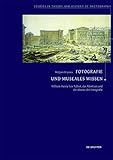Fotografie und museales Wissen : William Henry Fox Talbot, das Altertum und die Absenz der Fotografie / Mirjam Brusius.
Material type: TextSeries: Studies in Theory and History of Photography : Schriften der Lehr- und Forschungsstelle für Theorie und Geschichte der Fotografie am Kunsthistorischen Institut der Universität Zürich ; 6Publisher: Berlin ; Boston : De Gruyter (A), [2015]Copyright date: ©2015Description: 1 online resource (260 p.)Content type:
TextSeries: Studies in Theory and History of Photography : Schriften der Lehr- und Forschungsstelle für Theorie und Geschichte der Fotografie am Kunsthistorischen Institut der Universität Zürich ; 6Publisher: Berlin ; Boston : De Gruyter (A), [2015]Copyright date: ©2015Description: 1 online resource (260 p.)Content type: - 9783050063812
- 9783110380798
- 9783050095479
- 770 23
- TR140.T3 B77 2015
- online - DeGruyter
- Issued also in print.
| Item type | Current library | Call number | URL | Status | Notes | Barcode | |
|---|---|---|---|---|---|---|---|
 eBook
eBook
|
Biblioteca "Angelicum" Pont. Univ. S.Tommaso d'Aquino Nuvola online | online - DeGruyter (Browse shelf(Opens below)) | Online access | Not for loan (Accesso limitato) | Accesso per gli utenti autorizzati / Access for authorized users | (dgr)9783050095479 |
Browsing Biblioteca "Angelicum" Pont. Univ. S.Tommaso d'Aquino shelves, Shelving location: Nuvola online Close shelf browser (Hides shelf browser)

|

|

|

|

|

|

|
||
| online - DeGruyter Bildfelder : Stilleben und Naturstücke des 17. Jahrhunderts / | online - DeGruyter Sonne, Mond und Venus : Visualisierungen astronomischen Wissens im frühneuzeitlichen Rom / | online - DeGruyter Die Gegenwart des Mittelalters / | online - DeGruyter Fotografie und museales Wissen : William Henry Fox Talbot, das Altertum und die Absenz der Fotografie / | online - DeGruyter Ereck : Textgeschichtliche Ausgabe mit Abdruck sämtlicher Fragmente und der Bruchstücke des mitteldeutschen 'Erek' / | online - DeGruyter Odyssee : Griechisch - deutsch / | online - DeGruyter Käte Hamburger : Kontext, Theorie und Praxis / |
Frontmatter -- INHALTSVERZEICHNIS -- PROLOG -- EINLEITUNG -- TALBOTS MINDSET -- AUFZEICHNUNGSTECHNIKEN -- LONDON 1843 -- FOTOGRAFIE IM ZWEISTROMLAND -- TALBOT UND FENTON AM BRITISH MUSEUM -- EPILOG -- RÉSUMÉ -- ANMERKUNGEN -- QUELLEN UND ABKÜRZUNGEN -- BIBLIOGRAFIE -- ABBILDUNGSVERZEICHNIS -- NAMENSREGISTER
restricted access online access with authorization star
http://purl.org/coar/access_right/c_16ec
William Henry Fox Talbot (1800-1877) ist vor allem als Erfinder der Fotografie bekannt. Basierend auf neuen Quellen wird die Leistung Talbots hier erstmals im Hinblick auf sein Gesamtœuvre untersucht. Dies ermöglicht neue Interpretationen seiner Fotografien, die die Autorin primär als Hilfsmittel für seine vielfältigen wissenschaftlichen Interessen und somit als Teil eines epistemischen Gedankengebildes versteht. Da Talbot selbst maßgeblich an der Entzifferung von Keilschriften beteiligt war, propagierte er zunächst den Einsatz des Mediums im Museum und in der Archäologie. Als er jedoch die Seiten vom Erfinder zum Nutzer der Fotografie wechselte, wurde er zum Kritiker seiner eigenen Erfindung.
William Henry Fox Talbot (1800–1877) is best known as an early inventor of photographic processes. For the first time, based on extensive new sources, this study examines Talbot's inventions in the context of his entire oeuvre. This makes possible new interpretations of his photographs, which the author views primarily as an instrument for his diverse scientific interests, and thus as part of a broader epistemic conception.
Issued also in print.
Mode of access: Internet via World Wide Web.
In German.
Description based on online resource; title from PDF title page (publisher's Web site, viewed 04. Okt 2022)


